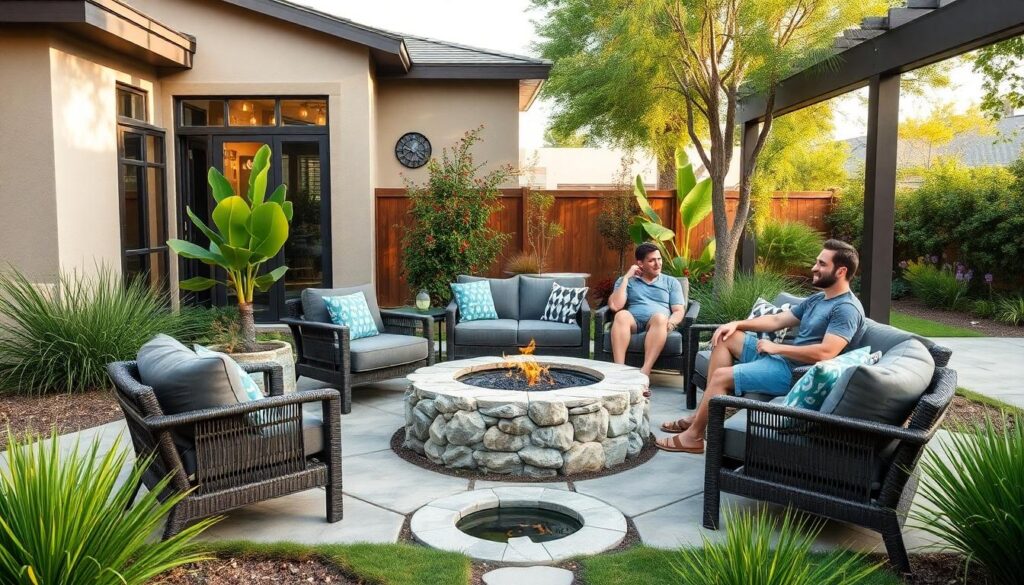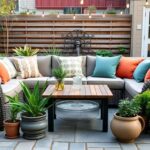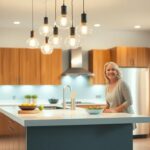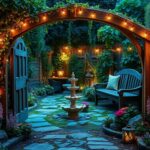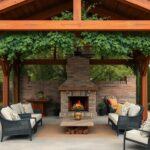Transforming your backyard into a stunning outdoor oasis doesn’t have to be complicated or expensive. We’ve gathered the most inspiring backyard design ideas that’ll help you create a space where memories are made and relaxation comes naturally. Whether you’re working with a small urban patio or a sprawling suburban yard, there’s something here for everyone.
10 Stunning Backyard Design Ideas to Transform Your Outdoor Space
1. Multi-Level Decking
Multi-level decking creates visual interest and defines different functional areas in your outdoor space. This design approach works particularly well for sloped yards, transforming challenging terrain into an architectural feature. Various levels can accommodate different activities—dining areas on one level, lounging spaces on another, and perhaps a hot tub on a third. Materials like composite decking offer durability with minimal maintenance, while natural hardwoods provide classic appeal even though requiring more upkeep. Adding integrated lighting between levels enhances safety and creates a dramatic evening ambiance.
2. Outdoor Kitchen and Dining Area
An outdoor kitchen elevates your entertaining capabilities beyond a basic grill station. Modern outdoor kitchens can include built-in grills, countertop space, refrigerators, and even pizza ovens. Weather-resistant cabinetry provides storage for utensils and supplies, keeping everything organized and accessible. Pairing the kitchen with a comfortable dining area featuring a substantial table and weather-resistant chairs creates a complete entertainment zone. Overhead structures like pergolas provide shade and can support fans or heaters to extend the usability of this space throughout different seasons.
3. Fire Pit Conversation Area
Fire pits serve as natural gathering spots that extend outdoor enjoyment into cooler evenings. Whether you choose a permanent stone fixture or a portable metal bowl, the dancing flames create an irresistible focal point. Surrounding your fire pit with comfortable, weather-resistant seating encourages conversation and relaxation. Options range from built-in benches to Adirondack chairs or outdoor sofas arranged in a circle. Fire glass as a modern alternative to traditional logs adds a contemporary touch with vibrant colors that complement your overall design scheme.
4. Water Features
Water features introduce a sensory dimension to your backyard with their soothing sounds and visual movement. From elaborate ponds with waterfalls to simple bubbling fountains, water elements create a tranquil atmosphere that masks urban noise. Pondless waterfalls offer the benefits of moving water without the maintenance requirements of a traditional pond. Wall fountains work wonderfully in smaller spaces, taking up minimal square footage while still providing the therapeutic benefits of flowing water. Solar-powered options eliminate the need for electrical connections and reduce operating costs.
5. Living Wall or Vertical Garden
Vertical gardens maximize planting space in limited areas while creating stunning visual impact. These living walls transform plain fences or exterior walls into lush tapestries of color and texture. Various systems are available, from pocket planters to modular panels designed specifically for vertical installation. Suitable plants include succulents, ferns, herbs, and flowering perennials depending on your climate and sun exposure. Automatic irrigation systems simplify maintenance, delivering water directly to plants’ root zones. Beyond their beauty, living walls provide additional insulation for adjacent structures and can help purify the air.
6. Pergola with Climbing Plants
Pergolas define outdoor rooms without fully enclosing them, creating a perfect balance of shade and airflow. These architectural structures provide support for climbing plants like wisteria, jasmine, or grapevines, which eventually form natural roofs of fragrant foliage. Retractable canopies can be added for additional sun protection on particularly hot days. String lights intertwined with the beams create an enchanting evening atmosphere for dining or entertaining. Modern pergolas come in various materials including traditional wood, low-maintenance vinyl, or powder-coated aluminum for different aesthetic preferences.
7. Zen Garden with Meditation Space
Zen gardens introduce tranquility through minimalist design elements and carefully arranged natural materials. Traditional components include raked gravel or sand, strategically placed rocks, and carefully pruned plants. A small meditation platform or seating area allows for contemplative moments amid the carefully crafted simplicity. Wind chimes and bamboo water features can enhance the peaceful atmosphere with gentle sounds. This design approach works surprisingly well in small spaces where elaborate landscaping might feel overwhelming, creating a sense of spaciousness through restraint.
8. Outdoor Home Theater
Backyard movie nights create memorable experiences for family and friends with relatively simple technology. Weather-resistant screens or light-colored walls serve as projection surfaces, while portable or installed projectors deliver the visual content. Wireless speakers provide clear audio without complicated wiring. Comfortable seating options might include weather-resistant bean bags, outdoor sofas, or even repurposed pallets topped with cushions. String lights or pathway lighting allow guests to navigate safely without interfering with screen visibility. For year-round enjoyment, patio heaters extend the movie season into cooler months.
9. Edible Industry Design
Edible landscaping seamlessly integrates food production with ornamental design, creating gardens that are both beautiful and productive. Fruit trees serve as focal points while providing seasonal harvests. Berry bushes make excellent hedges or borders with their attractive foliage and colorful fruits. Herbs interspersed among flowering perennials contribute fragrance and culinary benefits. Raised beds with geometric designs contain vegetables while adding architectural elements to the industry. Trellised crops like grapes or cucumbers create living screens that partition spaces while maximizing growing area.
10. Outdoor Art and Sculpture Garden
Artistic elements express personal style while creating visual interest throughout the seasons. Weather-resistant sculptures serve as focal points or unexpected discoveries along garden paths. Colorful mosaic elements can be incorporated into patios or walls, creating permanent interest. Kinetic sculptures moved by wind bring ever-changing elements to the industry. Specially designed lighting can highlight these artistic features after dark, creating dramatic effects. Even functional elements like benches or containers can be selected for their artistic merit, blending practicality with aesthetic appeal in a cohesive outdoor design.
Creating a Cozy Outdoor Living Room
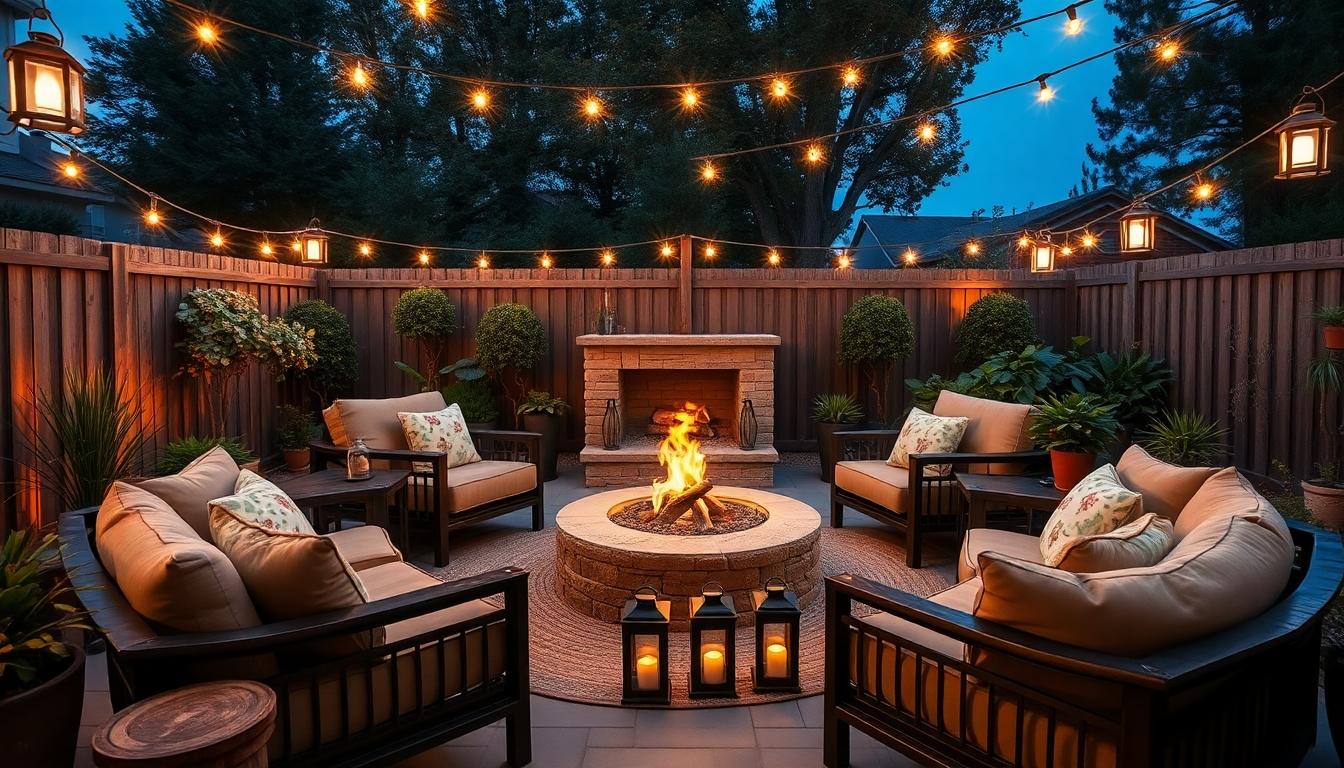
Transforming your backyard into a comfortable outdoor living space requires thoughtful planning and strategic design elements. By dividing your outdoor area into functional zones, arranging furniture for social interaction, and incorporating themed decor, you can create a cozy retreat that feels like an extension of your home.
Zone It Out
Dividing a large backyard into multiple zones creates purposeful areas that serve different functions. We recommend establishing a dedicated seating area centered around a focal point like a fire pit for evening gatherings. Your outdoor living room can coexist with separate dining zones, allowing for versatile entertainment options throughout your space. Strategic furniture placement facilitates conversation and social interaction, making guests feel welcome and comfortable. Arranging outdoor sofas in a conversational circle encourages face-to-face communication and creates an intimate atmosphere perfect for hosting friends and family.
Weather-Resistant Furniture Selection
Selecting durable outdoor furniture is essential for creating a living space that withstands the elements year-round. We prioritize materials like teak, metal, and recycled plastic for their exceptional weather resistance and longevity. Teak develops a beautiful silver patina over time while maintaining its structural integrity against moisture and insects. Metal options, particularly aluminum and powder-coated steel, offer lightweight durability with rust-resistant properties. Water-resistant fabrics for cushions and upholstery prevent mildew growth and color fading, extending the life of your outdoor seating. Furniture with water-draining designs prevents moisture accumulation that can lead to damage, ensuring your investment lasts for many seasons.
Ambient Lighting Options
Proper lighting transforms your outdoor living room from merely functional to magically inviting as daylight fades. We love string lights hung from trees or pergolas to create a warm, starry ambiance that enhances evening gatherings. Lanterns placed strategically on tables or along pathways serve dual purposes as decorative elements and practical light sources. Solar-powered lights offer a sustainable lighting solution that reduces energy costs while illuminating your outdoor space. These fixtures charge during daylight hours and automatically activate at dusk, requiring minimal maintenance while providing consistent illumination along walkways and garden borders. Layering different light sources at varying heights creates depth and dimension, making your outdoor living room feel complete and thoughtfully designed.
Designing a Backyard Kitchen and Dining Area
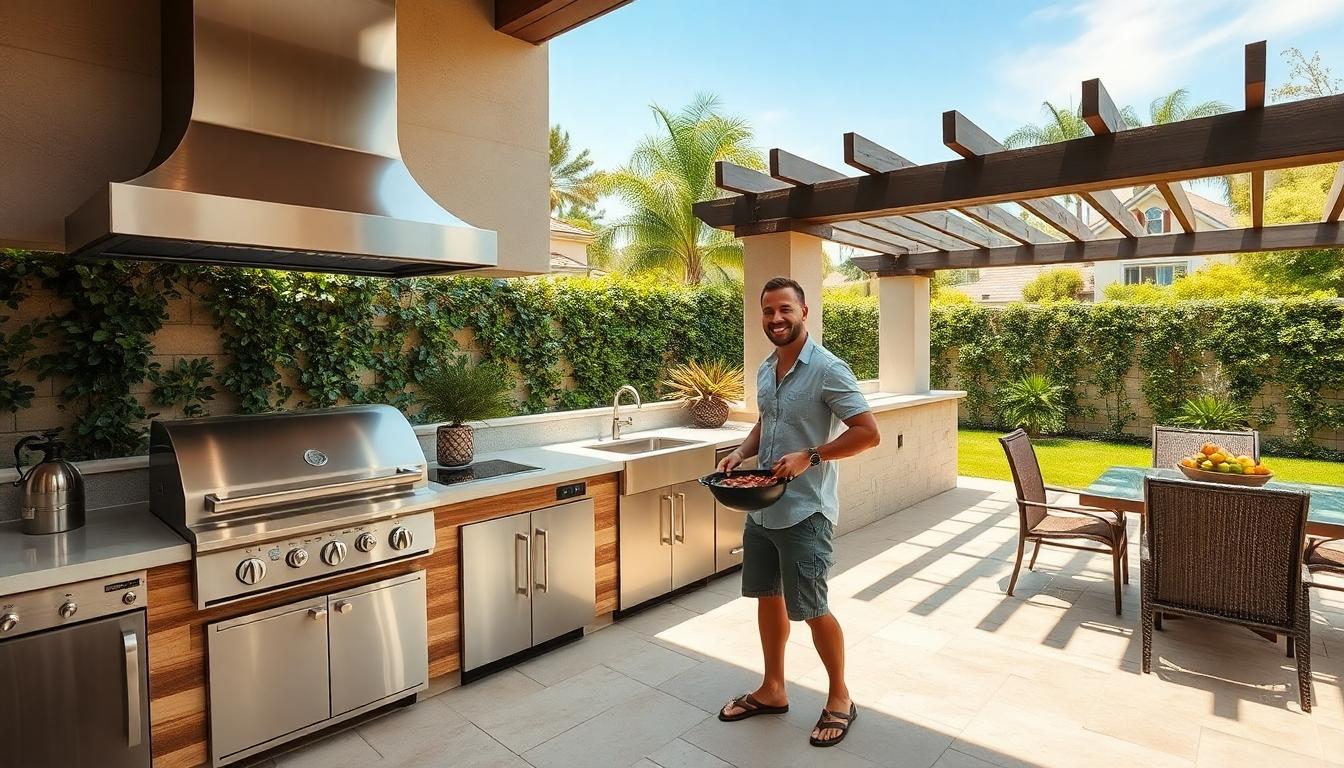
Built-In Grill and Counter Spaces
Modern backyard kitchens focus on functional layouts that make outdoor cooking a breeze. Built-in grills serve as the centerpiece, typically flanked by durable countertops made from stainless steel or weather-resistant stone for food preparation and serving. Storage answers like cabinets and drawers beneath counters provide convenient space for grilling tools and cookware, keeping everything organized and accessible. Materials such as brick or stucco help integrate your outdoor kitchen with existing patio walls, creating a cohesive look. Los Angeles designs showcase this seamless integration with elegant gray-brick pizza ovens that add both functionality and visual appeal to the space.
Sheltered Dining Setups
Pergolas and pavilions offer ideal protection for outdoor dining areas while maintaining essential airflow throughout the space. Covered dining zones adjacent to grilling stations, often illuminated by stylish sconces, create an intimate atmosphere for enjoying meals with family and friends. Standalone pavilions with classical designs complement your home’s architecture while providing shelter from the elements. Poolside kitchens featuring roofed structures, like those designed by Crisp Architects, allow you to enjoy magnificent views of your backyard while preparing meals. For smaller yards, compact L-shaped kitchen layouts paired with foldable dining furniture maximize the available space without sacrificing style or functionality.
Integrated Entertainment Zones
The best backyard kitchens blend cooking, dining, and lounging areas into one cohesive outdoor living space. Southern California designs use neutral color palettes accented with nature-inspired colors like yellow and green to harmonize with the surrounding industry. Multifunctional layouts that include sinks, refrigerators, and comfortable seating positioned near the grill create a streamlined hosting experience. These thoughtfully designed spaces encourage conversation and connection while allowing the host to remain part of the gathering even while cooking. Weather-resistant materials throughout ensure your outdoor kitchen and dining area will withstand the elements and provide enjoyment for years to come.
Incorporating Water Features for Tranquility
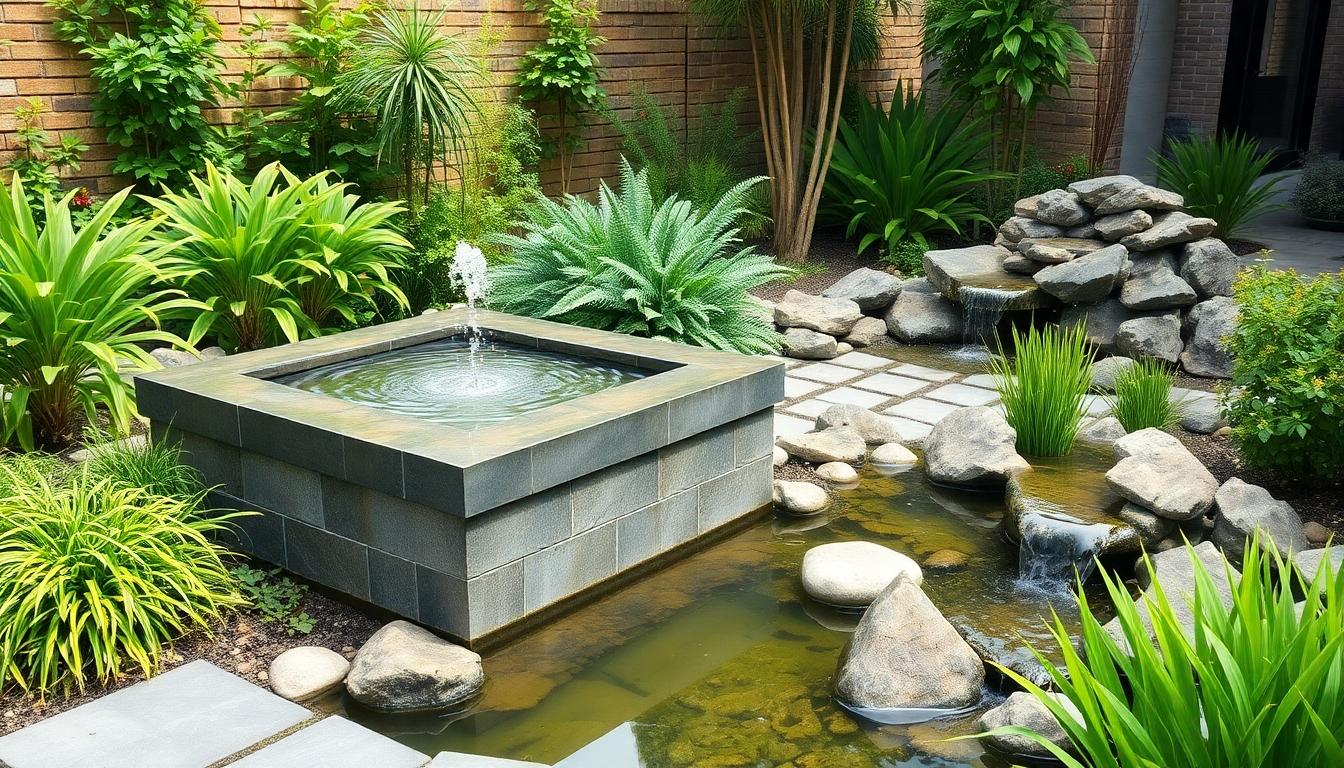
Water features are essential elements in backyard design that enhance both the serenity and aesthetic appeal of outdoor spaces. These calming additions create a peaceful atmosphere through the gentle sounds of flowing water and visual interest that transforms any garden into a tranquil retreat.
Modern Fountain Designs
Modern fountains offer sleek, contemporary options that blend seamlessly with various industry styles while providing soothing water sounds. Square fountains with disappearing basins present a chic, minimalist look that works wonderfully in structured outdoor spaces without taking up excessive room. Low Zen sphere fountains combine stylish design with meditative tranquility, creating perfect focal points for contemplative garden areas. Tiered fountains add vertical interest and produce delightful cascading water sounds that help mask unwanted noise from nearby streets or neighbors. Bubbling rocks provide a naturalistic water feature option that appears as if water is spontaneously emerging from your industry, requiring minimal space while delivering maximum sensory impact.
Small Pond Installations
Small ponds integrate beautifully into compact backyards, offering peaceful focal points without requiring extensive space. Miniature pond designs can include small waterfalls or fountains, creating serene environments even in limited areas of your garden. Pondless waterfalls provide the calming effects of moving water without the maintenance requirements of a full water body, making them ideal for smaller spaces or homes with young children. Reflecting pools add a sense of depth and serenity by mirroring surrounding plants and structures, effectively doubling the visual impact of your industry design. Regular maintenance through proper filtration and occasional cleaning ensures these water features remain healthy and visually appealing throughout the seasons. Strategic placement near seating areas maximizes the enjoyment of your pond’s tranquil atmosphere during outdoor relaxation time.
Landscaping with Native Plants and Gardens
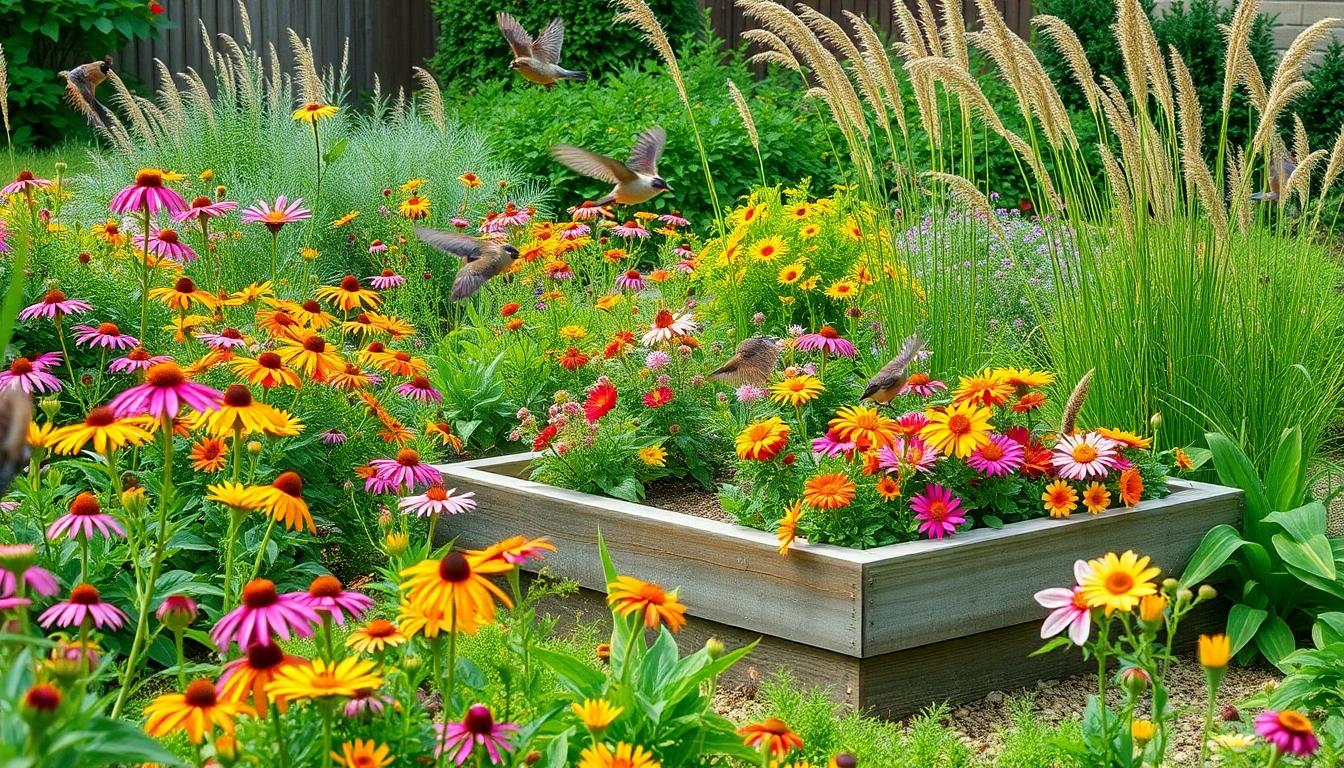
Transforming your backyard with native plants creates a sustainable, beautiful industry that connects with your local network. We’ve gathered expert tips to help you create a garden that’s both environmentally friendly and visually stunning.
Native Plant Selection
Native plants thrive in your local climate and soil conditions without requiring excessive care or resources. These regionally-adapted species naturally resist local pests and diseases, reducing the need for chemical interventions. Selecting natives like coneflowers, black-eyed Susans, or local grasses helps create a industry that requires less water and maintenance while supporting local wildlife. Your regional extension office can recommend exact varieties that will flourish in your particular growing zone and soil type.
Design Principles
Effective native garden design balances structure with natural beauty through thoughtful planning. Creating defined borders and paths helps organize your space while adding visual interest to the industry. Focal points draw the eye and give your garden character—consider incorporating a specimen tree, decorative boulder, or striking sculptural plant as a centerpiece. Planting in masses rather than individual specimens creates a more cohesive look and greater visual impact. Varying plant heights, textures, and bloom times ensures year-round appeal and creates a more ever-changing industry.
Wildlife Integration
Native gardens naturally attract and support local birds, butterflies, and beneficial insects. Incorporating native trees and shrubs provides habitat and food sources for various wildlife species. Plants like milkweed support monarch butterflies, while native sunflowers attract goldfinches and other seed-eating birds. Berry-producing shrubs offer food for birds while adding visual interest to your garden. Water features, even small ones, enhance wildlife attraction while adding a peaceful element to your outdoor space. Avoiding pesticides preserves this delicate network and maintains the natural balance in your garden.
Low-Maintenance Plant Selections
Choosing low-maintenance plants saves time and resources while creating a beautiful industry. Native plants have evolved to thrive in local conditions, making them naturally resistant to regional droughts, pests, and diseases. Prairie grasses like little bluestem or switchgrass prevent weed growth through their dense root systems and require minimal intervention once established. Grouping plants with similar water and light requirements simplifies care routines and ensures all plants thrive in their environment. Bold-textured specimens such as compass plant or Joe Pye weed add structural interest and contrast beautifully with finer-textured grasses and perennials.
Raised Garden Bed Layouts
Raised beds offer versatility and efficiency for native plant gardens in any backyard size. These elevated growing spaces provide excellent drainage and soil control, allowing you to create ideal growing conditions for exact native plant communities. Arranging beds in a grid pattern maximizes growing space while maintaining easy access for maintenance from all sides. Incorporating varying heights creates visual interest—taller plants at the center or back of beds with shorter species along edges allows all plants to receive adequate sunlight. Native wildflowers, grasses, and shrubs can be thoughtfully combined in raised beds to create miniature ecosystems that support local biodiversity while remaining manageable and visually appealing.
Installing a Fire Pit Gathering Space

A fire pit creates a natural focal point in your backyard that draws people together and extends your outdoor enjoyment into the cooler months. When planning your fire pit area, strategic positioning and thoughtful design can transform this feature into the heart of your outdoor living space.
Portable vs. Permanent Fire Pit Options
Portable fire pits offer exceptional flexibility for homeowners who want versatility in their backyard setup. These movable options allow you to reconfigure your outdoor space as needed and typically come with a lower price point than built-in alternatives. Many portable models require minimal assembly and can be stored away during off-seasons, making them perfect for smaller yards or rental properties.
Permanent fire pits deliver a sophisticated, integrated look that can significantly increase your property’s value. Built directly into your patio or industry, these fixtures often feature custom stonework or concrete construction that complements your overall outdoor design theme. Installation of permanent fire pits requires more substantial planning and investment but rewards you with a durable, weather-resistant gathering space that becomes a defining feature of your backyard.
Seating Arrangements Around Fire Features
Circular seating arrangements create the ideal conversation environment where everyone can face the fire while captivating with one another. This configuration naturally encourages interaction and ensures all guests have equal access to the warmth and ambiance of the fire. Consider implementing built-in seating walls or arranging individual chairs in a ring formation to achieve this effect.
Comfortable seating options significantly enhance the usability of your fire pit area throughout the seasons. Weather-resistant furniture such as outdoor sofas, Adirondack chairs, and sturdy benches provide the foundation, while soft elements like water-resistant cushions and cozy throw blankets invite guests to linger longer. Selecting materials that can withstand exposure to embers and seasonal elements ensures your seating will remain beautiful for years.
Visual balance within your fire pit space creates a more inviting and cohesive outdoor room. Incorporate decorative elements such as potted plants, outdoor lighting, or architectural features that complement your fire pit design. Themes like “Rustic & Refined” pair natural materials with clean lines, while “Lean & Green” approaches integrate plantings and sustainable materials for an eco-friendly gathering space that feels purposefully designed rather than simply placed in your yard.
Building a Deck or Patio Foundation
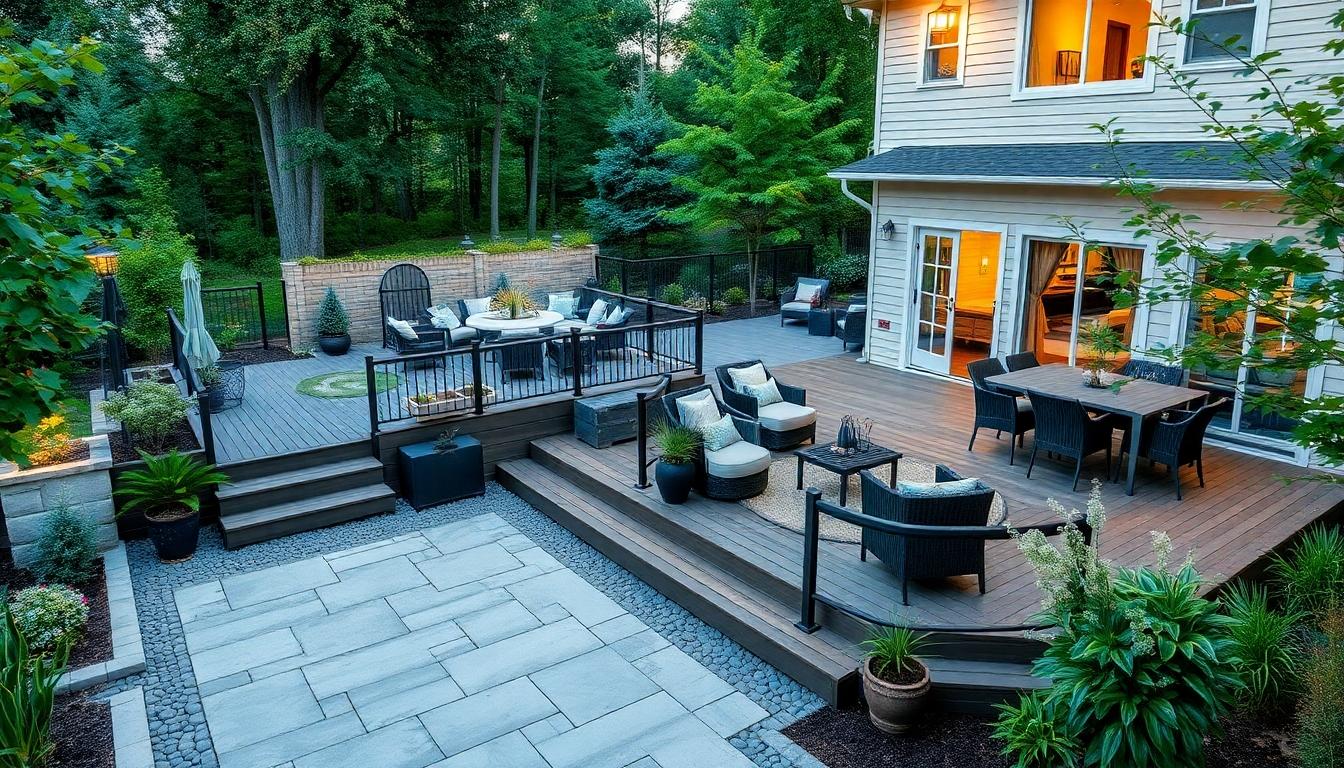
Creating a solid foundation for your outdoor living space starts with choosing the right materials. The structure you build will determine both the functionality and longevity of your backyard retreat.
Material Comparisons for Durability
When selecting materials for your deck or patio, durability should be a top consideration. Pressure-treated wood offers an economical option with protection against rot, though it may warp or crack over time as it faces the elements. Composite decking represents a step up in durability, boasting impressive resistance to rot and insects while requiring significantly less maintenance than traditional wood options. For patios, brick and concrete pavers stand out for their exceptional durability and weather resistance, often lasting decades with minimal upkeep. Cedar provides a naturally beautiful alternative for decking with its rustic appeal, though it demands regular maintenance to preserve its appearance. Concrete pavers offer versatility for patios with many style options at budget-friendly price points, while flagstone delivers a timeless natural aesthetic that complements most industry designs.
Multi-Level Design Concepts
Multi-level designs transform ordinary backyards into ever-changing outdoor living spaces with distinct functional areas. Terracing serves as an effective technique to create separate zones for different activities such as dining, lounging, or gardening while adding visual interest to your industry. Stairs and ramps connect these various levels, improving both accessibility and aesthetic appeal throughout your outdoor space. These elevated designs provide practical answers for managing sloped yards that might otherwise limit usable space. Privacy benefits emerge naturally from multi-level configurations, as height differences create natural visual barriers between areas. The additional square footage gained through terracing allows homeowners to maximize their outdoor living potential without expanding their property boundaries. Connecting elements like coordinated materials and repeated design motifs help unify the different levels into a cohesive outdoor experience that flows naturally from one space to the next.
Adding Privacy with Strategic Screening
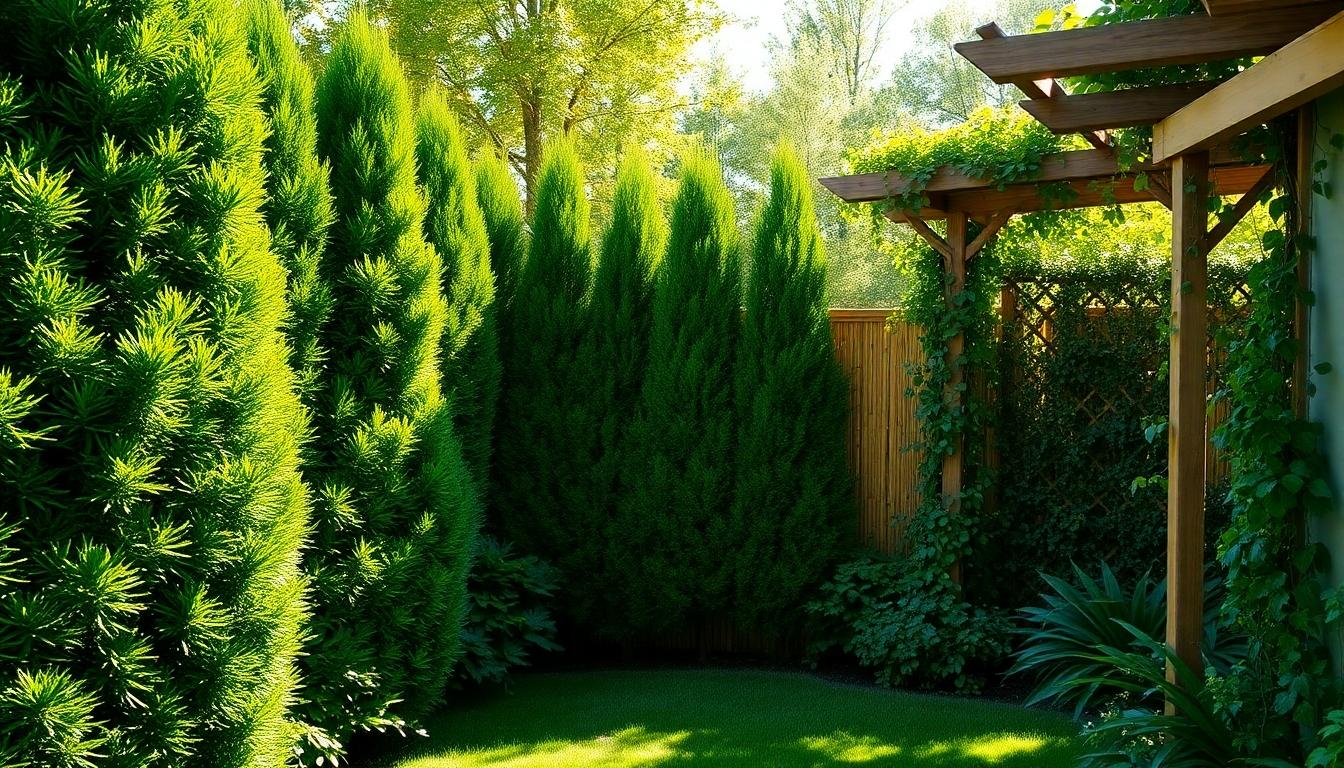
Creating a secluded outdoor retreat requires thoughtful screening answers that balance privacy with aesthetic appeal. Strategic screening transforms your backyard into a personal sanctuary while improving your industry design.
Plant-Based Privacy Screens
Evergreen plants offer excellent year-round privacy answers for your backyard. Thuja and Boxwood stand out as top choices due to their dense growth patterns and ability to maintain foliage throughout all seasons. These versatile plants create living walls that not only block unwanted views but also add natural beauty to your outdoor space.
When installing plant screens, consider the mature height and spread to ensure they’ll provide adequate coverage. Position them strategically around your property’s perimeter to create a natural boundary. For quick results, select fast-growing varieties and plant them closer together than typically recommended to create a denser barrier sooner.
Location for Privacy Screens
Placement of privacy screens significantly impacts their effectiveness. Install screens around your lawn’s outer edges to define boundaries while blocking outside views. Adding height to existing fences with decorative panels or climbing plants transforms ordinary barriers into standout industry features. For targeted privacy, use screens to enclose exact areas like patios or hot tubs, creating intimate outdoor rooms within your larger yard.
Weather considerations are crucial when positioning screens. Secure latticework screens firmly into the ground using posts or anchors to prevent wind damage. For lightweight screening options, attach them to existing structures like pergolas or fence posts to ensure stability during unexpected gusts.
Living Privacy Screens with Plants
Evergreen hedges provide reliable privacy answers that improve with age. Thuja and Boxwood create dense, uniform barriers when planted as a continuous hedge line. Their low-maintenance requirements make them practical choices for homeowners seeking lasting privacy without constant upkeep. For the most effective screening, plant these evergreens 2-3 feet apart to encourage their natural tendency to grow together.
Vines on trellises offer vertical privacy with seasonal interest and space efficiency. Clematis delivers stunning blooms while climbing hydrangea provides lush foliage and beautiful flower clusters. These climbing plants transform simple structures into living privacy screens that change throughout the seasons. Install sturdy trellises or wire supports to guide growth and provide necessary support for mature plants.
Garden borders with mixed plantings create layered privacy screens with visual depth. Combining deciduous and evergreen plants creates textural variety while ensuring year-round coverage. This approach allows for creative expression through seasonal color changes while maintaining the practical function of privacy screening. Arrange plants with taller species at the back and shorter varieties in front to maximize both privacy and visual appeal.
Decorative Fence and Panel Ideas
Bamboo fencing offers natural charm with eco-friendly credentials. This sustainable material provides instant privacy while serving as an excellent backdrop for additional planted screens. Bamboo’s natural color and texture bring warmth to outdoor spaces while effectively blocking unwanted views. For enhanced durability, look for treated bamboo panels that resist weather damage and insect infestation.
Weathered wood finishes add character and visual interest to traditional fencing materials. This aged appearance creates a lived-in, established look that blends harmoniously with garden plantings. Whether achieved through natural weathering or specialized treatments, this finish option softens the appearance of privacy structures while maintaining their functionality. Apply protective sealants to preserve the weathered aesthetic while extending the lifespan of your wood fencing.
Horizontal fencing designs create contemporary privacy answers with clean lines. This modern approach to fence construction makes spaces appear wider while providing solid screening from neighboring properties. The linear orientation draws the eye across the industry rather than upward, creating an expanded feel within enclosed spaces. Choose complementary materials like cedar or composite boards that enhance your overall industry design while delivering reliable privacy protection.
Creating Play Areas for All Ages
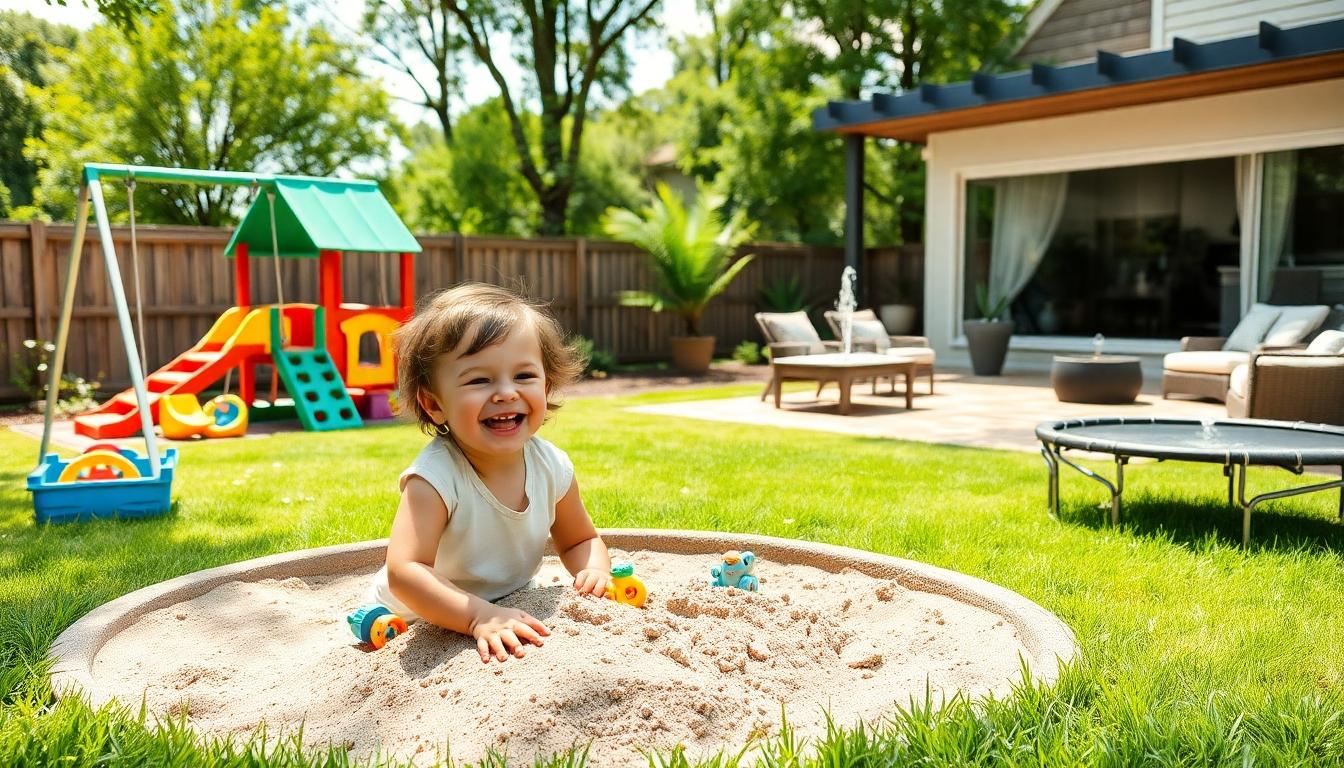
Transforming your backyard into a multi-generational recreational space ensures everyone in the family has areas to enjoy. Thoughtfully designed play zones can accommodate both children and adults, creating a cohesive outdoor environment where family members of all ages can connect.
Kid-Friendly Zone Designs
Kid-friendly backyard zones combine safety, creativity, and fun to keep children entertained for hours. Colorful playsets featuring swings, slides, and climbing structures serve as the centerpiece of any children’s area, encouraging physical activity and imagination. Adding a sandbox creates a sensory play experience where kids can build castles and dig to their heart’s content. Mini trampolines offer another dimension of active play, helping children develop balance and coordination while burning energy in a controlled environment. When designing these spaces, we recommend using soft ground covers like rubber mulch or specialized playground foam tiles to cushion potential falls. Positioning play equipment in partially shaded areas protects children from excessive sun exposure during peak play hours. For maximum engagement, incorporate elements that stimulate different senses and skills, such as musical features, balance beams, or water play stations that can be enjoyed throughout various developmental stages.
Adult Recreation Spaces
Adult recreation spaces transform ordinary backyards into sophisticated outdoor retreats for relaxation and entertainment. Outdoor kitchens equipped with built-in grills, countertop space, and comfortable seating create perfect gathering spots for hosting friends and family during warm weather. Designing dedicated relaxation zones with water features like ponds or fountains introduces a calming soundtrack to your outdoor living area. Comfortable lounge furniture arranged around these water elements creates ideal spots for reading, conversation, or simply unwinding after a long day. Fitness enthusiasts benefit from designated exercise areas featuring weather-resistant gym equipment or open, level spaces for yoga and meditation practice. Strategic placement of these adult zones allows parents to simultaneously supervise children in play areas while enjoying their own activities. Incorporating ambient lighting extends the usability of these spaces into evening hours, creating a magical atmosphere for adult socializing after younger family members have gone to bed.
Implementing Smart Lighting Systems
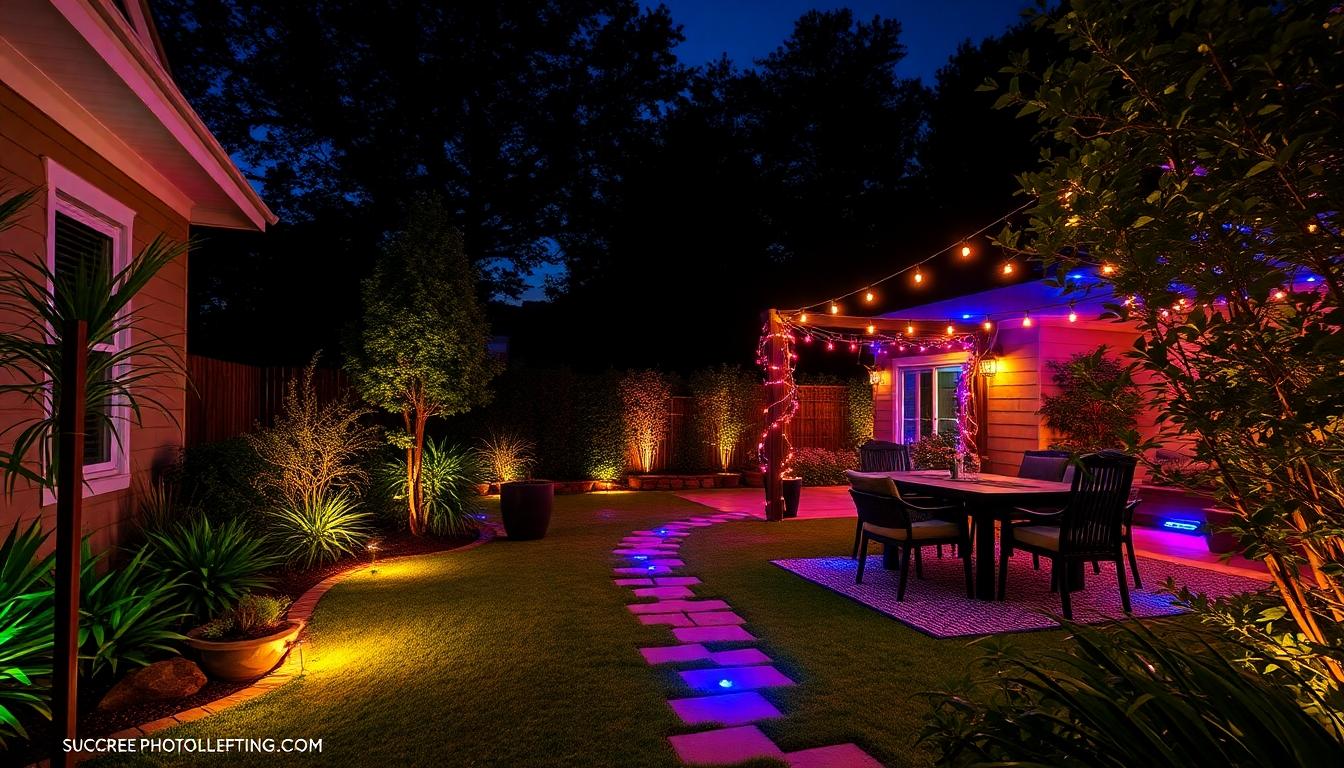
Transform your backyard into a nighttime paradise with intelligent lighting answers that combine technology with ambiance. Smart lighting not only enhances security but also creates the perfect atmosphere for any outdoor occasion.
Smart Control Systems
Philips Hue and similar smart lighting systems offer unprecedented control over your backyard illumination through convenient smartphone apps or voice assistants. Users can easily adjust brightness levels and select from millions of colors to match any mood or occasion, including seasonal themes for holidays and special events. Motion detection features provide enhanced security by automatically illuminating areas when movement is detected, deterring potential intruders while welcoming guests. These LED-based systems integrate seamlessly with existing home automation platforms, creating a cohesive experience between indoor and outdoor spaces while maximizing energy efficiency through scheduled operations and remote management.
Solar-Powered Pathway Lights
Solar pathway lights provide an eco-friendly solution for illuminating garden paths without the hassle of complex wiring or increased utility bills. These sustainable fixtures harness sunlight during the day and automatically activate at dusk, creating well-lit walkways along stairs, garden edges, and pathways. Stake-style designs can be easily inserted into the ground wherever needed, while decorative options add artistic elements to your industry during both day and night. The automatic dusk-to-dawn operation ensures your outdoor spaces remain navigable and inviting throughout the evening hours without requiring manual activation or monitoring. Their wire-free installation makes them perfect for remote areas of your yard where traditional electrical connections would be impractical or costly.
Automated Mood Lighting Answers
Preset lighting scenes accessible through smartphone apps allow homeowners to instantly transform their outdoor spaces for different activities with a single tap. Family dinners can be enhanced with warm, gentle illumination, while energetic gatherings benefit from brighter, more vibrant lighting schemes. Layered lighting designs combine multiple elements such as string lights draped over pergolas, LED strips along deck edges, and spotlights highlighting industry features to create depth and visual interest. Scheduling features enable automatic activation of different lighting scenarios throughout the evening, transitioning from practical illumination during early hours to more atmospheric settings as the night progresses. Energy-efficient LED technology and solar integration ensure these sophisticated lighting answers remain environmentally responsible while providing the versatility modern homeowners desire.
Sustainable Backyard Design Elements
Your backyard transformation journey doesn’t have to end with these ideas. We’ve shared diverse options from multi-level decks to smart lighting systems that can work for spaces of all sizes. By thoughtfully planning functional zones with durable materials and incorporating elements like native plants water features and fire pits you’ll create an outdoor sanctuary that reflects your personality.
Remember that the best backyard designs balance beauty with practicality. Whether you’re cooking in an outdoor kitchen relaxing by a fountain or gathering around a fire pit on cool evenings your backyard should be an extension of your home that brings joy year-round.
Ready to start your project? Pick one element that resonates with you and build from there. Your dream backyard awaits!
Frequently Asked Questions
How can I create different functional zones in my backyard?
Consider multi-level decking to naturally define separate areas for dining, lounging, and other activities. Use different flooring materials (like wood for dining areas and stone for fire pits) to visually separate spaces. Strategically place furniture to create conversation areas, and use pergolas or planters as dividers between zones while maintaining an open flow throughout your outdoor space.
What are the best materials for outdoor furniture?
Teak and metal furniture offer the best durability for outdoor use. Teak develops a beautiful silver patina over time and resists rot and insects. Powder-coated aluminum is lightweight, rust-resistant, and easy to clean. For cushions and fabrics, look for materials specifically designed for outdoor use with UV and water resistance. High-quality resin wicker is also an excellent option for a natural look with minimal maintenance.
How do I design an outdoor kitchen that’s functional?
Focus on a practical layout with a built-in grill as the centerpiece. Include durable countertops (granite, concrete, or stainless steel) for food prep and serving. Add storage solutions for utensils and cooking tools. Consider including a small refrigerator and sink if budget allows. Position your kitchen near the indoor kitchen for convenience and create adjacent dining space for easy serving.
What water features work best in small spaces?
Compact options like sphere fountains, wall fountains, or tabletop water features work beautifully in small yards. Consider a pondless waterfall that recirculates water without needing a large basin. Container water gardens with miniature aquatic plants fit on patios or decks. Small reflecting pools create a sense of spaciousness through mirror effects. These smaller features provide the soothing sounds and visual appeal without requiring extensive space.
Why should I choose native plants for my backyard?
Native plants are adapted to your local climate and soil conditions, requiring less water, fertilizer, and maintenance. They support local pollinators and wildlife, creating a healthier ecosystem. Native plants are naturally resistant to local pests and diseases, reducing the need for chemical treatments. They connect your garden to the surrounding landscape and regional identity while providing year-round interest with their natural growth cycles.
What’s better: a portable or permanent fire pit?
Portable fire pits offer flexibility to move around your yard, lower initial cost, and the ability to store them when not in use. Permanent fire pits provide a sophisticated, integrated look, potentially increase property value, and often offer better durability and safety features. Your choice depends on your budget, how frequently you’ll use it, whether you rent or own your home, and if you prefer versatility or a permanent focal point.
What decking materials require the least maintenance?
Composite decking offers the lowest maintenance requirements, resisting rot, warping, and insect damage without needing staining or sealing. It comes in various colors and textures that mimic wood. PVC decking is another low-maintenance option that resists staining and fading. While these materials have higher upfront costs than pressure-treated wood, they save significant time and money on maintenance over their lifespan, which can exceed 25 years.
How can I improve my backyard lighting?
Implement layered lighting with path lights for safety, accent lights to highlight landscape features, and ambient lighting for atmosphere. Install smart lighting systems that can be controlled via smartphone apps to adjust brightness and colors. Use solar-powered options for energy efficiency along walkways. String lights create a magical overhead canopy, while in-ground lights can illuminate trees from below. Consider automated systems that activate at sunset for convenience.
What’s the easiest way to create privacy in my backyard?
Strategic landscaping offers the most natural privacy solution. Plant fast-growing shrubs or ornamental grasses along property lines. Vertical gardens or living walls provide green screening in tight spaces. Bamboo creates dense, tall barriers quickly. For immediate results, install decorative lattice panels with climbing vines, freestanding privacy screens, or outdoor curtains around seating areas. Raised platform decks can also provide privacy from neighboring yards at different elevations.
How can I make my small backyard feel larger?
Use visual tricks like diagonal paving patterns to create the illusion of more space. Incorporate mirrors to reflect light and scenery. Choose multi-functional furniture that can be rearranged as needed. Create vertical interest with wall-mounted planters and climbing plants. Use a cohesive color scheme with lighter colors that make the space feel open. Consider creating different levels to add dimension and define zones without adding walls or barriers.

